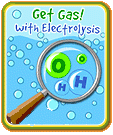
Experiment Category:
Objective:
What You Need:
- Two pencils (your every day HB pencil will work but #2's will work better)
- Two pieces of electrical wire about 30cm each
- A glass jar (approx. 500ml)
- A square piece of Cardboard large enough to cover the mouth of the jar
- Tape
- Water
- A lantern battery
- Salt
To Do and Observe:
Sharpen both ends of each pencil. Be sure to remove the erasers and any metal parts from the end of the pencils before trying to sharpen the ends. Fill the jar to just below the top with water. Add a few tablespoons of salt to the water filled jar. Tape the piece of cardboard to the top of the jar. Carefully, push one of the pencils through the cardboard so that the lead is completely under water. About three centimeters away, do the same with the other pencil. Be sure the leads of each pencil are at approximately the same level under the water. Using the wire, connect the exposed lead of the first pencil to the negative terminal of the battery. That is, wrap one end of the wire around the lead and the other end around the negative terminal. Connect the exposed lead of the other pencil to the positive terminal of the battery. We should now have one pencil connected to the negative battery terminal and another pencil connected to the positive battery terminal. The non-connected ends of the pencils should be submerged in the water. Bubbles should now begin to form at the two submerged leads of the pencils
What's Going On:
You have just created an electrolytic cell. The lead of a pencil is made of graphite which is a conductor. Electric current from the battery will flow from the negative terminal of the battery down through the lead, through the water and up the lead connected to the positive terminal. The lead attached to the positive terminal of the battery is known as an anode. The lead attached to the negative terminal is known as a cathode. The bubbles formed around the anode are oxygen gas (O2). The bubbles formed around the cathode are hydrogen gas (H2). The bubbles result from electrolysis, which simply means any process that creates a chemical change in an electrolytic cell. The chemical change in this case is the production of hydrogen and oxygen gas from water. You may notice more bubbles form around the cathode than the anode. This is because of the chemical structure of water, H2O. You can see that we will get two hydrogen gas molecules for every one oxygen molecule.
Parent/Teacher Tips:
The water must be lightly salted. If the water is too concentrated there is a very small chance that chlorine gas will be produced. Adding phenolphthalein (an ingredient in some laxatives) to the system will show the increase in pH near the cathode. It will turn pink. This can also be noticed with red cabbage juice. The juice turns blue at the cathode and red at the anode. This is often hard to see since the change in color is obscured by the dark purple of the cabbage juice. Try adding more batteries for a more dramatic bubbling effect.
